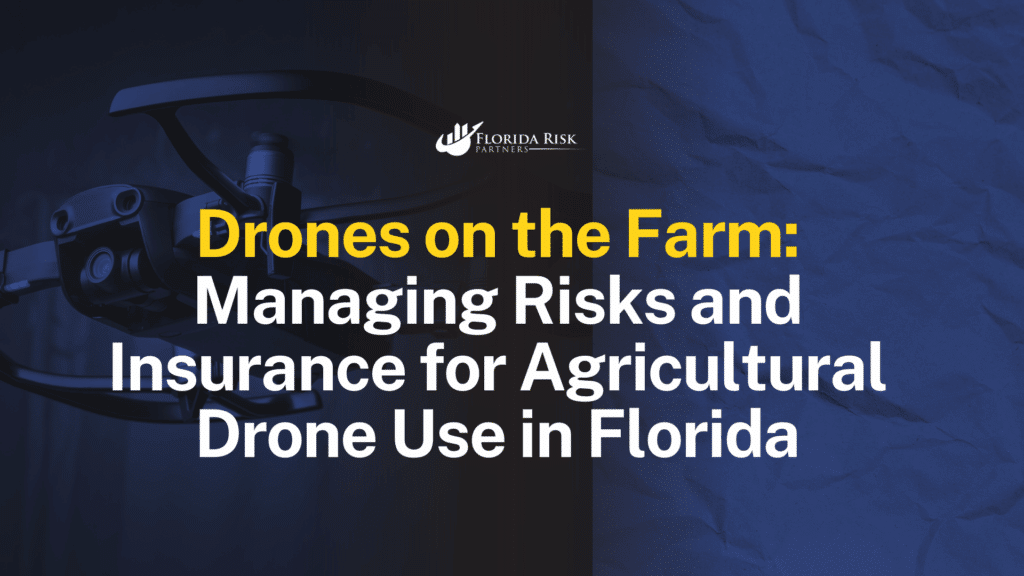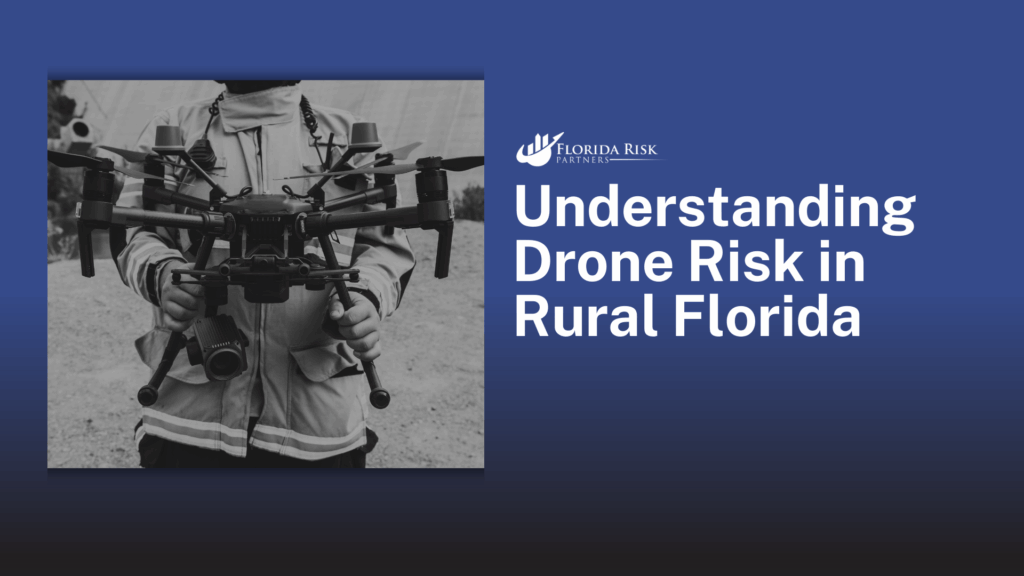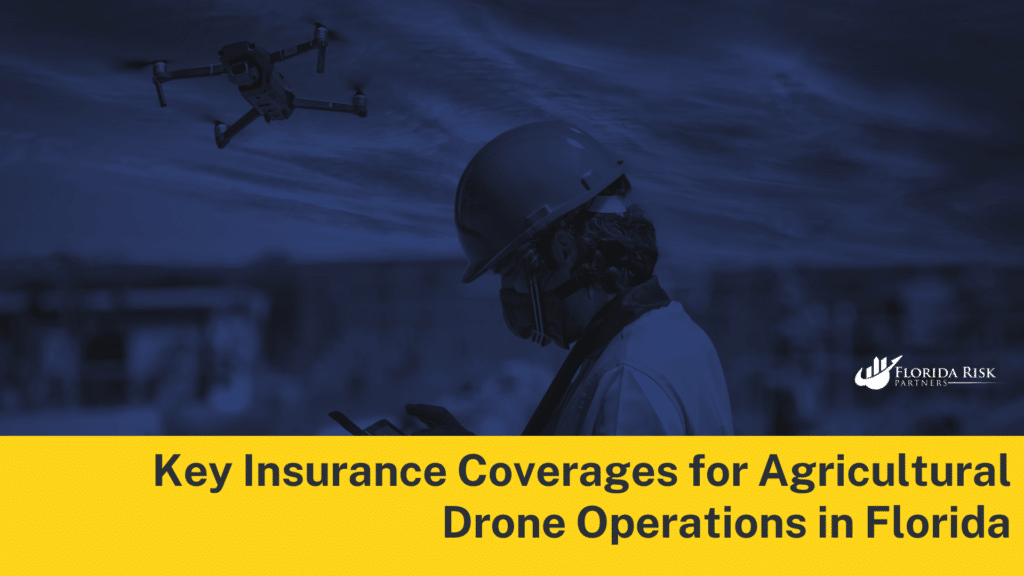-
Main Office: 1434 E. Bloomingdale Ave Valrico, FL 33596-6110
-
Phone: (888) 601-6660
-
Email: info@floridariskpartners.com

Florida’s farmland is vast and diverse, with citrus, cattle, sugarcane, and vegetables. Farmers face rising costs, labor shortages, and demand for data-driven efficiency. Drones help monitor crops, track irrigation, map fields, and aid pest control. As drones integrate into farming, risks grow, making insurance increasingly essential.
In this article, we’ll explore how drones are transforming Florida agriculture, the specific risks that come with using UAVs on farms, and how the right insurance coverage protects your equipment, your operation, and your financial future.
Florida Agriculture and the Drone Revolution
Agriculture is a cornerstone of Florida’s economy, with over 9 million acres of land in production and a wide range of crops, livestock, and agribusinesses spread across the state. From the orange groves of Central Florida to the sod farms and ranches in North Florida and the sugarcane fields of the Everglades Agricultural Area, each type of operation presents unique challenges—and drones are quickly proving to be one of the most versatile tools to meet them.
Farmers in Florida are using drones for:
- Aerial crop monitoring: Drones equipped with multispectral sensors can detect signs of plant stress, disease, or nutrient deficiencies before they’re visible to the naked eye.
- Irrigation inspection: Drones allow farmers to see how water is flowing (or not) across vast fields, identifying dry spots, leaks, or pooling areas.
- Mapping and planning: High-resolution imagery helps create accurate field maps for planting and harvesting.
- Livestock management: In large pastures, drones can track herd movement, locate stray animals, and monitor fences.
- Pesticide and fertilizer application: Specialized drones are being used to apply crop treatments with pinpoint accuracy, reducing chemical use and labor costs.
These applications save time, reduce overhead, and generate actionable data for better decision-making. But they also introduce new risk exposures—to both the equipment and the surrounding environment. And because many Florida farms are located near residential areas or public roads, farm drone liability extends beyond just the boundaries of the property.
Understanding Drone Risk in Rural Florida
Operating drones in rural areas comes with its own set of risks—some obvious, others less so. Florida’s rural terrain, while offering plenty of open space, also brings complications such as high winds, wildlife, large equipment, and proximity to neighboring properties. Below are some of the most pressing rural drone risks Florida farmers should be aware of.
Equipment Loss or Damage
Drones used in agriculture often fly at lower altitudes and closer to obstacles—trees, irrigation pivots, power lines, barns, silos, and even livestock. Combine that with Florida’s ever-present weather volatility—afternoon thunderstorms, gusty winds, or intense heat—and you have a recipe for increased crash risk. Drones may get stuck in treetops, dive into water troughs, or simply short out in the humidity.
The cost of replacing a drone and its sensor payload (which could include infrared, thermal, or LIDAR equipment) can be several thousand dollars or more. Without hull coverage as part of your farm UAV insurance Florida policy, that cost falls squarely on the farmer.

Livestock Interaction
Florida’s cattle ranches and equine farms pose a lesser-known risk to drone operations. UAVs flying too close to animals can startle them—leading to injuries, broken fences, or even escaped animals. If your drone spooks a herd that tramples a neighbor’s fence or injures someone, you could be liable.
In these situations, drone liability insurance for agricultural use is essential. It helps cover costs associated with third-party property damage, injury, or legal claims—even if the drone didn’t physically touch anything but triggered an event indirectly.
Neighboring Properties and Trespass
Many Florida farms border residential subdivisions, public roads, or other private lands. While flying your drone over your own acreage is legal, an unintentional drift onto neighboring property—especially if you’re capturing images or video—could be construed as invasion of privacy or even trespass under Florida’s strict drone laws.
The Freedom from Unwarranted Surveillance Act in Florida makes it illegal to use drones to record private property without consent. If your drone accidentally records a nearby property owner in their backyard, you could face a lawsuit. In this case, personal injury coverage under an agricultural drone insurance policy can help mitigate your exposure by covering legal defense and settlement costs.
Pesticide Drift and Liability
Some Florida farms have begun using UAVs for crop spraying, applying pesticides or fertilizers via drone in targeted zones. While efficient, this practice comes with its own set of liability risks. Pesticide drift—when chemicals travel onto neighboring properties—can damage crops, harm pets or wildlife, or expose humans to unwanted contact.
If a spraying drone malfunctions or drifts off-course due to wind, the operator may be held liable for damages, even if they were acting in good faith. This makes drone insurance for Florida crop spraying a crucial safeguard for any operation employing aerial chemical application.
Key Insurance Coverages for Agricultural Drone Operations in Florida
To protect your farm and your bottom line, it’s important to work with an insurance provider that understands both the agricultural and drone industries. A quality agricultural drone insurance policy in Florida should include the following key components:
Drone Liability Coverage
This covers third-party injury or property damage, such as spooking a neighbor’s horse, damaging a power line, or crashing into a neighbor’s barn. Liability limits typically start at $500,000 and can be adjusted based on your operation’s size and exposure. It also often includes coverage for personal and advertising injury, which protects against privacy violations or trespass claims related to drone footage.
Hull and Payload Coverage
This is the “physical damage” portion of your policy—covering your drone and its attached payload in case of crash, water damage, theft, or malfunction. This is particularly important in Florida due to high humidity, unpredictable weather, and remote operating conditions that make recovery of lost drones more difficult.
Ground Equipment Coverage
In addition to the drone, you likely rely on controllers, monitors, batteries, tablets, chargers, and ground station devices. These items are often vulnerable to theft or damage while transporting between fields, especially in trucks, trailers, or barns.

In-Transit and Theft Coverage
Florida farmers are mobile. Drones are often moved between fields or stored in utility sheds or truck beds—making them prime targets for theft or in-transit damage. Coverage for these exposures can be added to most policies and is well worth the investment.
Weather-Related Damage
As we discussed in Week 6 of this blog series, Florida’s weather is one of the biggest threats to drone safety. Check your policy to confirm coverage for loss due to wind, lightning, rain, or storm-related mechanical failure. Some insurers also offer coverage for drone use during post-storm inspections or insurance documentation after hurricanes.
Commercial Use Endorsements
If you’re using drones on the farm as part of a for-profit operation—whether you’re spraying crops, mapping fields, or creating media for agritourism ventures—make sure your policy includes a commercial use endorsement. Using a recreational drone policy for commercial activities can void your coverage.
Best Practices for Safe Agricultural Drone Use in Florida
Having insurance is essential, but avoiding incidents in the first place is even better. Here are a few safety and operational tips for Florida farmers using drones:
- Get your FAA Part 107 certification. This not only ensures you understand federal airspace rules but also qualifies you to operate legally for business purposes.
- Establish a pre-flight checklist. Include weather checks, battery status, obstacle awareness, and fail-safe programming (like return-to-home settings).
- Fly early in the day. In Florida, the weather is typically calmer and more predictable in the morning, reducing the risk of wind-related incidents.
- Avoid flying near livestock without prior exposure. Let animals acclimate to drones gradually to avoid startling them.
- Create and store field maps. Use software to designate no-fly zones around homes, barns, and neighboring property boundaries.
- Keep logs of all flights. This helps with maintenance tracking, operational compliance, and insurance documentation in case of a claim.
Why Insurance is Non-Negotiable in Today’s Farm Operations
Drones are becoming as essential to modern farming as tractors and irrigation. They provide valuable insight, reduce manual labor, and make farm operations more efficient. But they also carry risks—legal, mechanical, and environmental—that can’t be ignored.
With Florida’s tight privacy laws, variable weather, and close-knit rural communities, the chances of encountering a claim-worthy incident increase with every flight. Whether you’re flying over 10 acres of strawberries in Plant City or managing a cattle ranch in Ocala, agricultural drone insurance in Florida gives you the financial cushion to recover from the unexpected and keep your operation running smoothly.
In many cases, having a robust insurance policy is also a requirement. If you’re contracting with government agencies, agricultural co-ops, or even major buyers, you may be required to show proof of insurance before you’re allowed to provide drone-based services.
Final Thoughts: The Sky’s the Limit—If You’re Protected
Drones are helping Florida’s farmers produce more with less, improve sustainability, and stay competitive in a challenging industry. But like every powerful tool, drones require responsible use—and responsible risk management. That means choosing the right gear, following the right rules, and investing in the right insurance.
By understanding the specific risks of drones in Florida agriculture and choosing a farm UAV insurance policy that addresses those exposures, you’re not just flying smarter—you’re securing your livelihood.
Next week, we’ll head back to the coast to explore how drones are shaping the future of Florida’s real estate and tourism industries—and the special considerations that come with flying in crowded residential and commercial areas. Until then, keep your eyes on the sky—and your policies in order.
Call Us Or
Schedule an Appointment
Select an agent below to view our online calendars and select a day and time that works best for you or call us directly at 888-601-6660. When you use our online calendars, you will receive an email with more information.



